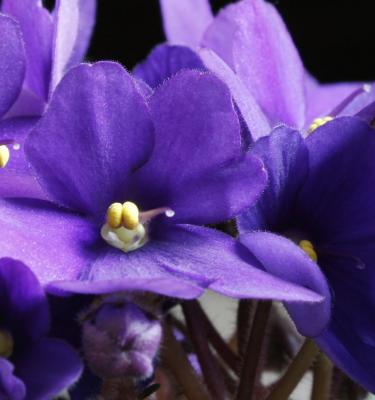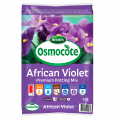

How to grow & care for African Violets
African violets are typically grown as indoor plants, but they will also tolerate growing outdoors in a protected warm, part-shade spot.
With dainty flowers in white, pinks or purples and soft velvety leaves African violets make very attractive houseplants. You can even find cultivars with double, frilly flowers and variegated foliage.
African violets prefer to receive 6-8 hours of indirect sunlight per day. They don’t like sun (particularly hot afternoon sun) directly hitting their leaves, so choose a spot with filtered morning sun only or a lot of in-direct bright light.
Top 5 steps to growing African Violets
- African violets do well as indoor plants in a spot with bright indirect sunlight.
- Do NOT water African violets from the top of their potting mix or overhead - instead sit in a saucer of water to absorb the water they need or use a wicking pot.
- African violets prefer a potting mix that retains moisture, but is also free draining look for a specific African violet potting mix like Scotts Osmocote African Violet & Cyclamen Mix
- Turn African violet pot regularly to encourage even growth and remove spent flowers or yellowing leaves.
- African violet velvety leaves can collect dust, but do not like to be wet - so use a soft paint brush to gently brush off any dust.
Shopping List
- An African violet plant
- Scotts Osmocote Pour+Feed for Flowering Plants
- Scotts Osmocote African Violet & Cyclamen Mix
- A suitable pot with drainage holes or look for a specific African violet wicking pot
- Garden trowel
Preparation
African violets are best grown in pots and they will need a bright spot indoors (away from direct sunlight that can burn their leaves) or a warm, sheltered spot outdoors. Remember they are not frost tolerant and prefer a fairly consistent temperature of 15-26 degrees Celsius and a humidity around 60%. Avoid placing your African violet near a heating or cooling vent where it will be blasted with changes in temperature.
Choosing the right potting mix like Scotts Osmocote African Violet & Cyclamen Mix that both retains moisture, but is free draining is important. Pot selection is also critical - choose a pot that is 1 size up from the existing nursery pot of your African violet. Terracotta pots with a drainage hole and saucer OR a specialist wicking pot are ideal for African violets.
Planting & Care
Half fill your pot with Scotts Osmocote African Violet & Cyclamen Mix. Gently remove the African violet from the nursery pot and tease the roots lightly if they are compact. Plant it into the potting mix and backfill around the plant.
The initial watering in can be from the top of the potting mix, using tepid water, ensuring no water touches the leaves of your African violet. All further waterings are best done when the top of the potting mix feels dry to touch, but water from the base of the pot.
To water from the base either sit your pot with a drainage hole in a saucer or trough of water that sits 5cm up the sides of the pot for an hour and then remove it to drain. Or use a self-wicking pot and refill the water reservoir as needed.
Fertilising
African violets will benefit from a fortnightly application of half-strength Scotts Osmocote Pour+Feed for Flowering Plants to really boost flower production during spring and again in autumn.
Pests & Diseases
African violets are mostly pest and disease free. From time to time mites may cause a problem and you’ll notice stunted growth and greying/silvery leaves - if this happens spray infested foliage on both sides with Defender Pyrethrum Insect Spray.
Crown rot and mildew can occur if African violets are overwatered or left sitting in a pool of water. Mildew can be reduced by removing infected foliage and improving air circulation around the plant. Crown rot unfortunately is normally fatal and the best approach is to start again with a new plant.



